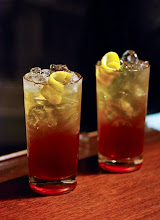So, as promised, here's the infusion: short, sweet & clarified slightly from its initial appearance at the Ministry of Rum many moons ago. As an aside, in this particular infusion, though the overall proof of the spirit (from 80 to about 75, in case you were wondering) drops somewhat due to the inclusion of certain of the ingredients, this infusion nevertheless makes a marvelous addition to spring & summertime cocktails well after Blood Oranges are out of season – an example of which I’ve included just after the recipe. You can even enjoy it (like a certain friend of mine does - on the beach for Labor Day) straight over an ice cube or two...
Blood Orange Cachaça
750ml: Cachaça (Pitu works well here)
5x fresh Blood Oranges, washed
3 Tblspns. Raw Sugar
1 Tblspn. white Sugar
1 Tblspn. Lemongrass, minced
½ Tsp. Cardamom, removed from pods (optional)
1½ Tblspns. Water
‡ ‡ ‡ ‡ ‡ ‡
1. Carefully peel Blood Oranges, being sure to remove & discard all bitter pith from the skin.
2. Likewise remove & discard all pith and seeds from the flesh of two of the Oranges. Seperate into segments.
3. Clean & mince Lemongrass & shell Cardamom. Toast Cardamom seeds in a small pan.
4. Combine ingredients in a clean container & add Cachaça.
5. Seal container & swirl/shake vigorously.
6. Place in a cool, dark location for approximately 7-10 days, swirling vigorously several times.
7. Strain 2-3 times by preferred method (coffee filter, cheesecloth &c), pressing on solids to remove all liquid.
9. Strain or rack again as necessary & bottle.
Enjoy in any cocktail (as appropriate, flavor-wise) which calls for Cachaça - a Caipirinha w/ half lime & half blood orange muddled works nicely. Or you could try it in the following libation (or come up with your own uses – and pass them along to me in the comments section if you’re so inclined):
 Sangriento Rabo de Galo
Sangriento Rabo de Galo2 oz. Blood Orange Cachaça
¾ oz. Carpano Antica Formula
¼ oz. Aperol
1 dash Angostura bitters
Stir with ice & strain into a cocktail glass. Garnish with a slice of fresh Blood Orange.
But now that you've labored (not for all that long really) at preparing the above infusion, why not stick around the kitchen a bit longer - perhaps for a lovely spot of dinner that will make handy use of some of the extra (Lemongrass, Blood Oranges &c.) ingredients from your infusion...?
Roast Quail stuffed w/ Savory Veal Couscous

6x Quail, cleaned & marinated
Savory Veal-Couscous Stuffing (see below)
Grande Duchess Potatoes (see below), to plate
Manchego Cheese, shaved thin for garnish
Marinade:
1 Cup Lillet Blanc
2 Tblspns. Honey
Zest of ½ Blood Orange
2 Tsp. fresh Tarragon, chiffonade
1 Tsp. Herbes de Provence blend
¾ Tsp. Coriander, coarsely-crushed
½ Tsp. white Pepper
Savory Veal-Couscous Stuffing:
½ lb. Veal, ground
1 Cup medium Couscous
½ Cup fresh Blood Orange juice
½ Cup Veal stock (or sub. ½ Beef & ½ Chicken stocks)
6 Tblspns. Butter, unsalted
1 Tblspn. Honey
2x cloves Garlic, minced
2 Tblspns. green Onions, chiffonade
2 Tblspns. Lemongrass, chiffonade
1½ Tsp. fresh Tarragon, chiffonade
Fluer de Sel & black Pepper, to taste
‡ ‡ ‡ ‡ ‡ ‡
1. Prepare the marinade by combining listed ingredients in a plastic bag, agitating to mix, and adding cleaned Quail. Marinate the birds for approximately two hours in the refrigerator.
2. Prepare the Couscous stuffing as follows:
3. In a medium saucepan over low-medium heat, melt Butter and saute Garlic, Lemongrass & Onions until fragrant (about 2 minutes).
4. Brown the ground Veal in the same pan.
5. Add remaining ingredients, stir well & bring to a simmer over low-medium heat.
6. Place the Couscous in a bowl & when liquid mixture is simmering, add to the container. Stir well & cover with plastic wrap to steam for approximately ten minutes.
6. Preheat oven to 375°. Remove Quail from marinade & drain before generously stuffing with Couscous mixture. Reserve ½ Cup of marinade.
7. Arrange stuffed Quail in a 9x13 dish or braising pan & deposit reserved marinade in bottom.
8. Place prepared Quail in preheated oven & cook for 25-30 minutes, or until well-bronzed. Remove, allow to rest for about 2 minutes & plate with:
Grande Duchess Potatoes
2½ lbs. Potatoes, peeled
2x cloves Garlic, minced
¾ Cup: Heavy Cream
8 Tblspns. Butter, unsalted & divided
½ Cup: Manchego cheese, shredded & packed
3x Egg yolks, divided & beaten
Generous pinch of Nutmeg, freshly-grated
Fluer de Sel & black Pepper, to taste
‡ ‡ ‡ ‡ ‡ ‡
1. Clean & boil Potatoes in salted water as per ordinary mashed potatoes.
2. In a small saucepan over low-medium heat, melt the Butter & allow to brown slightly (not quite beurre noisette) before adding Garlic.
3. Saute Garlic over low heat until fragrant (about 1-2 minutes) then slowly stir in Heavy Cream & Cheese.
4. Bring to a gentle simmer, stirring often & remove from heat.
5. Drain Potatoes & allow to stand, uncovered, for about 5 minutes (so that some amount of moisture may evaporate).
6. In a small bowl, temper two of the beaten Egg yolks by slowly adding the Butter-Cream mixture & whisking aggresively.
7. Whip Potatoes smooth by preferred method, slowly adding Butter-Cream mixture & seasoning with Nutmeg, Fluer de Sel & black Pepper.
8. On a silicon-lined baking sheet divide mashed potatoes into six equal portions; the ambitious may wish to pipe the warm potatoes into a whimsical arrangement.
9. Gently brush the formed potatoes with the remaining beaten Egg yolk & place in the oven at 375° for approximately ten minutes (this may be placed in the oven with the Quail if you wish), or until crisp on top. The ambitious may then further crisp the top with a culinary torch, but this step is not really necessary.
Cheers & Enjoy!

+Jersey+Cocktail+039.jpg)
+Jersey+Cocktail+032.jpg)

.jpg)





